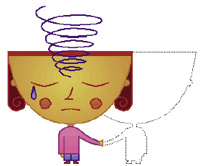
This patient handout will help prevent health crises in mourning patients and demonstrate that you care.
Fam Pract Manag. 2003;10(10):49

I practice family medicine in a small and geographically isolated community in northern California in which people have learned to look out for one another. Though I’ve only been here for seven years, my office staff have known many of my patients for three decades or more. Every Thursday, when the local paper comes out, Barbara (my office manager) looks through the obituary section and affixes sticky notes to items of interest, saying, “That’s your patient’s mother” or “This is Mrs. So-and-so’s spouse.” Then, I know it’s time to make a condolence call and put a copy of my Mourners’ Rights handout in the mail. I write a one- to two-line personal message at the top and sign my name at the bottom. Sometimes I discover during a visit that my patient is a mourner. Then I immediately reach for the handout and we go over it together.
Why bother?
I share the Mourners’ Rights handout with my patients for three important reasons: it saves time, it prevents health crises and it reminds my patients that I am committed to them.
It saves time because knowing that I’ve put my thoughts on paper allows me to focus on listening to the patient. Before I wrote the handout, I found myself trying to express its main ideas using more words than necessary. It saves time the way all handouts do: by allowing the patient to read it over and over without the doctor having to speak the words over and over. With those patients who tend to be reticent, it saves time by eliminating the portion of a phone call or visit during which the patient wonders aloud whether it’s appropriate to be “bothering you”; it clarifies that all symptoms of mourning are legitimate topics for discussion. With those patients who tend to obsess over each new symptom, it saves time by providing reassurance and backing up your advice should you later diagnose a symptom as a benign manifestation of grief.
The handout prevents health crises by giving patients a critically important but often unpublicized piece of information: As mourners, they are at high risk of having health problems right now, and their doctor and other health care professionals can make a real difference by intensifying care in this period. Until I wrote the handout, I had noticed that most of my hypertensive, diabetic and hyperlipidemic patients would give up their exercise programs for prolonged periods during mourning, and patients of all kinds would lose track of medication refills and other aspects of self-care. These mourning patients needed extra reminders and attention to ensure their own health care needs were not being neglected.
The handout is one of the most direct ways I know to tell my mourning patients I am here for them, not because they are “holding it together,” not because they are “falling apart,” but because they are human. The opportunity to be a permanent ally to a human being, regardless of age, gender, diagnosis or prognosis is one of the great privileges of being a family physician. When we validate our patients’ experiences and welcome their hearts in this way, they are deeply, openly and repeatedly appreciative.